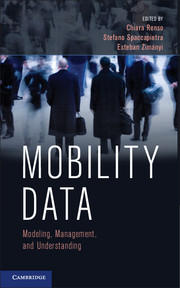Book contents
- Frontmatter
- Contents
- List of Contributors
- Preface
- Acknowledgments
- PART I MOBILITY DATA MODELING AND REPRESENTATION
- PART II MOBILITY DATA UNDERSTANDING
- PART III MOBILITY APPLICATIONS
- 10 Car Traffic Monitoring
- 11 Maritime Monitoring
- 12 Air Traffic Analysis
- 13 Animal Movement
- 14 Person Monitoring with Bluetooth Tracking
- PART IV FUTURE CHALLENGES AND CONCLUSIONS
- Bibliography
- Glossary
- Author Index
- Subject Index
- Plate section
12 - Air Traffic Analysis
from PART III - MOBILITY APPLICATIONS
Published online by Cambridge University Press: 05 October 2013
- Frontmatter
- Contents
- List of Contributors
- Preface
- Acknowledgments
- PART I MOBILITY DATA MODELING AND REPRESENTATION
- PART II MOBILITY DATA UNDERSTANDING
- PART III MOBILITY APPLICATIONS
- 10 Car Traffic Monitoring
- 11 Maritime Monitoring
- 12 Air Traffic Analysis
- 13 Animal Movement
- 14 Person Monitoring with Bluetooth Tracking
- PART IV FUTURE CHALLENGES AND CONCLUSIONS
- Bibliography
- Glossary
- Author Index
- Subject Index
- Plate section
Summary
Introduction
The goal of air traffic control (ATC) is to maximize both safety and capacity, so as to accept all flights without compromising the life of the passengers or creating delays. Because air traffic is expected to double by 2030, new visualizations and analysis tools have to be developed to maintain and further improve the safety level. To do so, air traffic practitioners analyze data from the ATC activity. These multidimensional data include aircraft trajectories (3D location plus time), flight routes (ordered sequences of spatio-temporal points that represent planned routes), and meteorological data. In this chapter, we detail the relevant tasks of ATC practitioners and demonstrate recent visualization and query methods to fulfill them.
The special properties of ATC data propose new challenges and, at the same time, new opportunities of data analysis. The semantics of the data are rich because they includes the third dimension (altitude), which can be used to discover salient events such as takeoffs and landings. More semantics can be added by augmenting background data such as the traffic network and the meteorological data. ATC data sets are characterized by their large sizes, adding more challenges to the analysis. Trajectory analysis is difficult due to the data set size and to the fact that it contains many errors and uncertainties. One day's traffic over France contains about 20,000 trajectories (> 1 million records). Recording is done in a periodic manner (in our database: a radar plot, per aircraft, every 4 minutes), but a plot can be missed, or have erroneous data because of physical problems that occur at the time of recording.
- Type
- Chapter
- Information
- Mobility DataModeling, Management, and Understanding, pp. 240 - 258Publisher: Cambridge University PressPrint publication year: 2013
- 2
- Cited by



